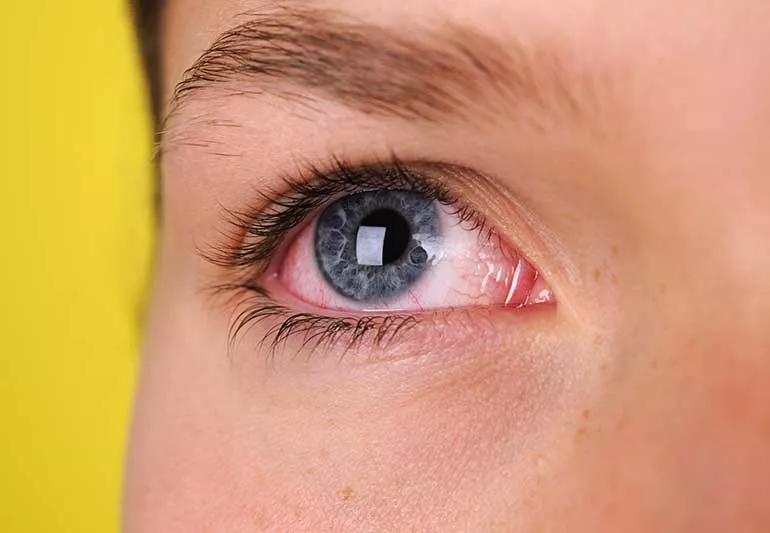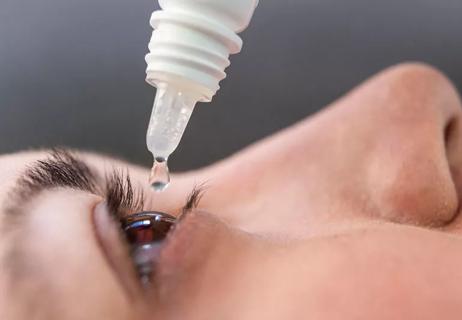How to tell the difference between harmless redness and issues that demand attention

No one wants to look in the mirror and find a pair of red eyes staring back. Most of the time, that angry coloring is just a harmless reaction to dust or allergens and nothing to get overly worried about.
Advertisement
Cleveland Clinic is a non-profit academic medical center. Advertising on our site helps support our mission. We do not endorse non-Cleveland Clinic products or services. Policy
But that’s not always the case. Sometimes, inflamed eyes signal that you need to see an eye doctor — and the sooner the better.
How can you tell the difference between what’s a concern and what’s not? Ophthalmologist Nicole Bajic, MD, outlines a few conditions that could give your eyes a reddish hue and what to do about them.
Research shows that between 2% and 3% of all people visiting primary care physicians and emergency rooms come in because of an eye issue — and the majority of those people have red eyes.
Here are six conditions that can cause people’s eyes to become irritated and red:
Do you consistently get a burning, itchy or gritty feeling in your peepers? If so, you may be dealing with dry eyes, the perfectly descriptive term for what happens when you don’t have enough tears.
Believe it or not, three layers of tears provide a protective film over your eyes. If the waterworks slows down, your eyes may turn red and uncomfortable, particularly if they’re exposed to an allergen or irritant.
A variety of factors aside from allergens — including weather, computer screen use, medications and surgeries — can contribute to dry eye. The condition also can become a more common issue with age.
Advertisement
Treatment: The good news is that over-the-counter lubricating drops known as “artificial tears” can make your eyes feel better, sometimes within minutes. The substance offers much-needed lubrication.
Allergy drops also may help reduce symptoms if your dry eye symptoms are allergen-based.
But Dr. Bajic cautions against using eye drops marketed specifically to reduce redness. The reason? The drops may actually make your dry eyes worse over time.
“The drops shrink surface blood vessels so your eyes look whiter,” she explains. “But because the blood vessels are squeezed shut, you’re getting less fluid to your eyes, so you’re actually drying them out more, and the redness comes back with a vengeance. It’s a vicious cycle.”
Broken blood vessels on the eye’s surface (subconjunctival hemorrhage) may look and sound alarming, but they’re typically nothing to worry about. The broken vessels are usually painless and don’t affect your vision.
So, what causes that bloody vessel to appear on your eye? It could be any number of reasons, including:
Treatment: It just takes time. “They’ll get better by themselves in a week or two,” says Dr. Bajic. Consider using artificial tears if you experience some irritation. (But if there’s pain, see an eye doctor.)
Kids bring a lot home from school — including pink eye (aka, conjunctivitis).
This type of eye infection is so common among younger children it’s practically an elementary school rite of passage. The condition is incredibly contagious, a truth that explains how it’s so easily shared in classrooms, notes Dr. Bajic.
Anyone of any age can get it, though. Just ask the parent of a child with pink eye.
Pink eye occurs when viruses, bacteria or irritants (such as chlorine) cause inflammation and infection of the mucous membrane lining in your eyes. There are about 6 million cases of pink eye reported in the United State every year.
The infection’s well-known nickname is a perfect description of how conjunctivitis looks. The white part of your eye turns a reddish-pink color that’s … well, pretty obvious to anyone looking at you. It can give you an itchy, burning feeling, too.
Your eyelids also may get puffy and droopy, and it’s not unusual for a goopy discharge to cause crusting on your eyelashes and eyelids.
Advertisement
Treatment: Mild to moderate cases of pink eye typically clear on their own without treatment within a week. Using nonprescription “artificial tears” may help ease itching and burning. (Avoid other types of eye drops, which may irritate your eyes.)
But a visit to the doctor may lead to a prescription antibiotic that can shorten the length of the infection and reduce your chances of spreading it to others.
Bacteria, viruses, allergies, fungi or parasites (usually waterborne) all can cause an infection in your eyes. This general ickiness often can be transferred to your eyes from your hands if you rub at your peepers.
Pain, light sensitivity and blurred vision are sometimes signs of serious infection. Untreated infections can cause erosion on your eye’s surface that can permanently damage your eyes.
Treatment: It’s best to get in to your eye doctor’s office within a few days if signs of an infection pop up. If you wear contacts and you suspect you have an infection, get to your doctor immediately.
Here’s an alarming statistic: About 30,000 Americans lose their vision every year because of a group of eye diseases known as uveitis. The condition may also lead to eye problems such as glaucoma or cataracts.
Advertisement
Red eye can be a visible sign of uveitis, which involves inflammation within your eye. Other symptoms include light sensitivity, blurred vision, pain and dark “floaters” popping up in your field of vision.
People who smoke are more prone to uveitis. It can also result from an eye injury, infections (such as the herpes virus or chickenpox virus) or inflammatory diseases.
But an estimated 1 in 3 uveitis cases has no known cause.
Treatment: It’s critical to see an eye doctor for an exam as soon as possible if you experience uveitis symptoms. “Immediate treatment can limit tissue damage and maybe restore any lost vision,” says Dr. Bajic.
Fluid within your eye naturally flows out through an intricate drainage system. If these exit canals somehow get blocked, it can lead to a sudden and dramatic rise in pressure inside of your eye.
Red eye may be a visible symptom of this relatively rare condition known as closed-angle glaucoma. This eye disorder also may cause severe eye pain, headaches, nausea and cloudy vision.
The risk of closed-angle glaucoma increases with age. It’s also more common among people with a family history of the condition.
Treatment: This is an emergency situation that demands medical attention. “If acute angle closure isn’t addressed right away, you can dramatically and forever lose vision,” stresses Dr. Bajic.
Advertisement
Three symptoms connected to red eyes — pain, extra light sensitivity and blurred vision — stand out as potential signs of a larger problem and deserve quick attention, states Dr. Bajic.
In addition, contact your eye doctor if you experience unusual dryness, redness or other symptoms for more than a day or so. A vision issue can sometimes reveal other health issues.
“Causes of red eye cover a wide spectrum, including emergency conditions that need to be taken care of as soon as possible,” says Dr. Bajic. “Don’t ignore concerning symptoms. There really could be something serious going on.”
Learn more about our editorial process.
Advertisement

How and when to use over-the-counter drops

Most recommended precautions center around minimizing bruising or swelling

Even one drink can have an impact on your cognitive function leading to slurred speech, blurred vision and impaired memory

Understand who may (and may not) benefit

Lorem ipsum dolor sit amet. Et odio Quis vel ipsam omnis eum alias deleniti et placeat impedit non voluptas galisum hic autem enim et cupiditate aliquid. Est beatae quidem non facilis autem ut commodi nisi aut tempore rerum et dolores voluptatem cum enim optio id sapiente quasi. Ad laboriosam officiis 33 cupiditate sequi ea voluptatum consectetur qui necessitatibus voluptate et quasi doloremque et facere explicabo quo explicabo officia

Type 2 diabetes isn’t inevitable with these dietary changes

Applying a hot or cold compress can help with pain